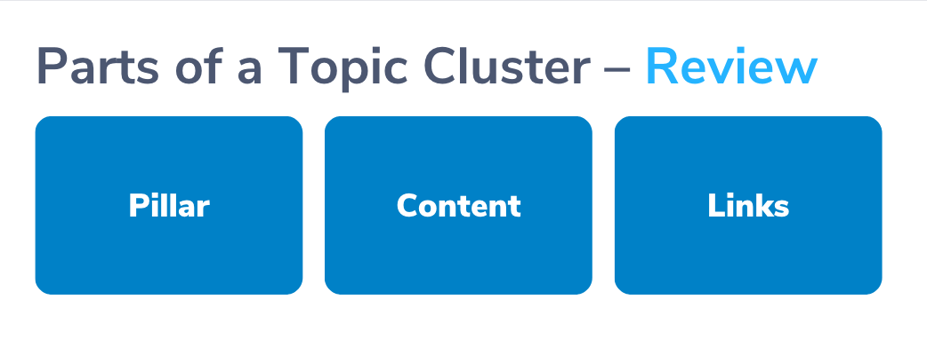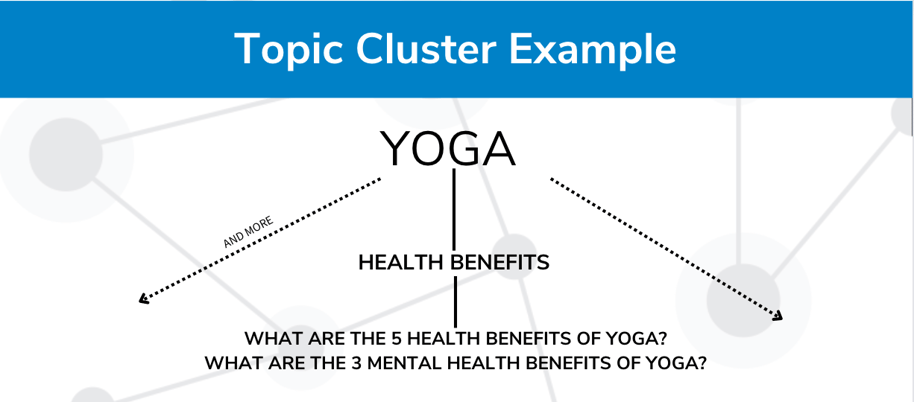What is a Topic Cluster in Marketing?
March 25, 2022 •McKenzi Sidor

In the world of marketing, SEO proves vital to increasing traffic to your website. In fact, organic search is responsible for 53% of all site traffic, according to this study. The easier it is for readers to find your website, the higher the odds that those readers will actually view your site.
To increase your chances of getting on the first page of search engines, it isn’t always enough to use a few SEO keywords. The most successful marketing stems from creating a topic cluster. What is the topic cluster model?
It is an SEO pillar and accompanying content that relates and hyperlinks to each other. Let’s take a more in-depth look at what each part of a topic cluster is and some topic cluster examples.
Parts of a Topic Cluster
Pillar: The topic cluster pillar page is a lengthy piece of content (about 3,000 words) that gives a general overview of a widely searched keyword. That central keyword should be the focus of the pillar, and you should use 15 to 20 other keywords or phrases within the pillar to increase the likelihood of your pillar page appearing on the first-page search engine results.
Content: From the pillar page, you can get more specific with topics you might have briefly mentioned in your pillar to create content. Sub-pillars are pieces of content that consist of about 2,000 words and are slightly more specific than a pillar page. These pages usually use 10-15 SEO keywords. These sub-pillars then can be broken down into more specific topics to create blogs of about 750 words with 6-8 keywords in it. The blogs are where you answer one specific question that stemmed from the sub-pillar.
Links: This piece of the topic cluster is important because it’s what connects your content to your pillar page. Both the sub-pillar pages and the blogs should have the title of the pillar somewhere within them. The blogs should also include the title of their respective sub-pillar.
Think of topic clusters as the rabbit hole searches you do. You click on one page, and after you read the article, you think of a related question that you are curious about, so you find another page from there. You keep finding more questions upon reading each page until you are far down the rabbit hole. By creating a topic cluster for your initial keyword, you make it easier for your readers to find your related pages after finding the first one.
Topic Cluster Examples
Now that you know the basic parts, how do you identify a topic cluster? Let’s look at some examples of them. Let’s say that after doing some research you decide that the keyword you want to use as your pillar page is yoga. From there, you might decide to write a sub-pillar on the health benefits of yoga. It’s a little more specific than your pillar, but still broad enough that you can give an overview with a lot of information. From this sub-pillar, you might choose to write blogs on things like what happens if you do yoga every day, what are the five health benefits of yoga, and what are the three mental health benefits of yoga.
Another example of a pillar page might be handyman services. From there you might write a sub-pillar about the handyman price list of 2021. From that, you can write blogs answering questions about how to estimate a handyman job, what the daily rate is for a handyman, and what type of work a handyman can do legally.
So what’s the big picture? Understand how your target audience might think. When you give them a keyword, what sorts of questions will they ask? What will they want to know more about? When you create a topic cluster, you give them the answers to all the questions they might be thinking of while boosting visits to your website.
How Do You Create a Topic Cluster?
The next question you might be asking is how do you create a topic cluster? Is there some sort of topic cluster tool that you can use to help you out? The answer is yes. DemandJump offers a topic cluster generator that allows you to put in a keyword that you want to make a pillar page out of and will suggest sub-pillars and supporting blogs that relate to that initial keyword.
DemandJump also creates a list of high-value keywords that relate to your pillar that can be included in your pillar page and other content. The report that DemandJump generates will show you how your competitors rank with those keywords so that you can determine which you should use to boost activity to your page. If you want to make creating topic clusters easy, get started using DemandJump today for free!
Featured Articles
Categories
- Attribution Tracking (13)
- Channel Optimization (11)
- Consumer Insights (68)
- Content Marketing (251)
- Data Science (8)
- Digital Marketing (6)
- Digital Transformation (26)
- Enterprise (10)
- Lead Generation (14)
- Market Intelligence (8)
- Marketing Analytics (39)
- Marketing Attribution (57)
- Marketing Management (153)
- Marketing Operations (86)
- Organic Search (222)
- Paid Search (52)
- Pillar-Based Marketing (63)
- Programmatic Advertising (9)
- SaaS Content (14)
- SaaS Marketing (29)
- Search Marketing (111)
- SEO Keyword Research (28)
- SEO Pillar (18)
- SEO Strategy (46)
- SMB (5)
- Website Content (12)


